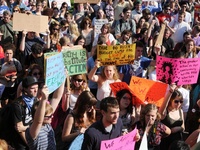
Protesters wave their signs to draw attention to their issues, including financial reform, support for education, and decreased corporate influence in the electoral process.
BOSTON—Hundreds of protesters, including a Harvard contingent of more than 80 students and affiliates, gathered on the Boston Common Monday for an “Occupy Boston” rally, passionately chanting “This is what democracy looks like!”
Tuesday morning around 1:30 a.m., tensions rose high in Dewey Square as scores of police officers cautioned protesters, including several Harvard students, to vacate the Square, where the activists have been camped out since Oct. 1. The officers subsequently began arresting activists at one of the camps.
Voicing their discontent with the current state of politics and the economy. the protesters have taken over Dewey Square, located in the heart of Boston’s financial district across the street from South Station.
Monday’s rally brought affiliates of various Boston-area universities together on the Common before they set off to march through the financial district. As protesters proceeded from the Common, the numbers grew into the thousands.
Before joining the rally in Boston Common, Harvard students gathered in front of the John Harvard statue to show solidarity with other sympathetic members of the Harvard community.
Hannah L. Hofheinz, a fifth year doctoral candidate at the Harvard Divinity School, was one of the many organizers of the “Occupy Harvard” event. Hofheinz cited her concern for the future of the United States as her inspiration for standing with the Occupy Boston movement.
“Or country is hurting, and people are hurting,” Hofheinz said. “It’s important that, as students, human beings, people, that we come together and change [these] social systems.”
The Occupy Boston movement drew its inspiration from Occupy Wall Street, a protest movement which began in mid-September in New York.
Graduate School of Arts and Sciences Student Marisa M. Egerstrom was previously involved with Occupy Wall Street and is now supporting Occupy Boston.
Speaking to the crowd gathered in front of University Hall, Egerstrom explained what she sees as a unique opportunity for social change.
“What we have is an opportunity in America to organize in ways that I haven’t seen in the history of the last 40 years,” Egerstrom said. “And many of us have been pissed off for a very long time, but what we’re finding is that a new form of hope is coming to life.”
Occupy Wall Street and Occupy Boston have until now been seen as primarily left-leaning student movements with no clear goals, but as the number of supporters grows, the demographics are becoming increasingly diverse.
In addition to members of Harvard’s Student Labor Action Movement, the audience at the Occupy Harvard event included members of several religious groups as well as members of the conservative grassroots Tea Party movement.
“You can’t categorize this as a bunch of disgruntled hippies being against stuff just to be against stuff,” Egerstrom said.
Egerstrom disagreed with the way in which the protests are being portrayed, explaining that the familiar protest narratives of the 1960s and 1970s are different from Occupy Boston.
Read more in News
UC Consolidates Web Resources













